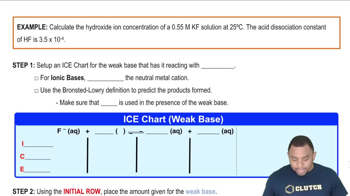Here are the essential concepts you must grasp in order to answer the question correctly.
Solubility Product Constant (Ksp)
The solubility product constant (Ksp) is a measure of the solubility of a sparingly soluble ionic compound. It represents the equilibrium between the solid and its ions in solution. For aluminum hydroxide (Al(OH)3) and magnesium hydroxide (Mg(OH)2), their Ksp values indicate the concentrations of ions at which precipitation occurs. A lower Ksp value means that the compound is less soluble, leading to precipitation at lower ion concentrations.
Recommended video:
Solubility Product Constant
pH and Hydroxide Ion Concentration
The pH of a solution is a measure of its acidity or basicity, which affects the concentration of hydroxide ions (OH-) present. In a buffer solution with a pH of approximately 8, the concentration of OH- ions is sufficient to precipitate Al(OH)3, as aluminum ions can react with hydroxide ions to form a solid. However, the concentration of OH- at this pH is not high enough to exceed the solubility of Mg(OH)2, preventing its precipitation.
Recommended video:
Hydroxide Ion Concentration Example
Cation Precipitation and Selectivity
Cation precipitation refers to the process where cations in solution react with anions (like hydroxide) to form an insoluble compound. The selectivity of precipitation is influenced by the Ksp values of the compounds formed. In this case, Al3+ precipitates as Al(OH)3 due to its lower Ksp compared to Mg2+, which means that at the same concentration of hydroxide ions, Al(OH)3 will form a solid while Mg(OH)2 remains dissolved.
Recommended video:




